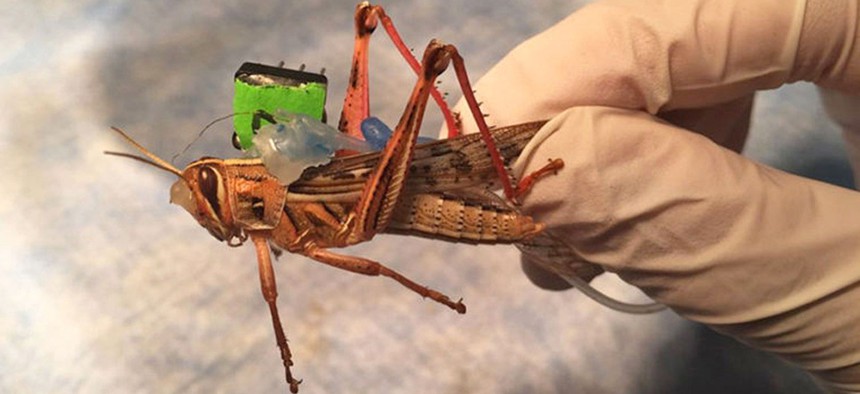
Last week, the US Office of Naval Research awarded researchers at the University of Washington in St. Louis, Missouri $750,000 over three years to alter locusts to remotely sense bombs and other explosive devices. Baranidharan Raman
The Navy Is Rigging Locusts to Sniff Out Bombs
Although dogs’ noses remain the gold standard for chemical detection, bugs' simpler neurological system make them easier to engineer and control.
Insects engineered to detect explosives sound like something out of a sci-fi movie, but they may become a reality for the US military.
Last week, the US Office of Naval Research awarded researchers at the University of Washington in St. Louis, Missouri $750,000 over three years to alter locusts to remotely sense bombs and other explosive devices. These locusts could detect chemical changes in areas with possible dangers, like land mines, with their antenna, and alert users sitting far away in safety.
“The chemical sensing part of these insects is extremely well developed,” Baranidharan Raman, a biomedical engineer at the University of Washington in St. Louis and one of the members of the project, told Popular Science. “They can smell a new odor that comes into the environment within a few hundred milliseconds.”
A sense of smell is really just the ability to pick up different kinds of chemicals in the air. Raman told the BBC that both humans and locusts have the ability to pick up one chemical among many others, like smelling burning toast in a room with flowers in it. However, artificial technology that has tried to mimic natural senses of smell, like the ones in animals, still can’t make as many distinctions among chemicals.
Some mammals have already been trained to find explosive odors human noses can’t pick up, like dogs, dolphins, and even elephants and rats. Although dogs’ noses remain the gold-standard for chemical detection technology, the advantage of using bugs is that they have a less complicated neurological system, making them easier to engineer and control. The surgery to modify locusts to be able to transmit sensory data is relatively simple. Raman told producers at KWMU, a local St. Louis radio station, that these insects can recover from surgery in about a day “and behave as if nothing had happened.”
The ideal bomb-finding bug would be able to fly into hard-to-reach places, chemically sense explosives, and alert military personnel accordingly. To direct the insects, researchers plan to tattoo specially engineered silk onto locusts’ wings. This tattoo will convert laser light into heat to goad the bug to fly in different directions. A small electrode implanted into the locust’s brain with surgery will allow users to sense what the insect’s antenna are picking up. Information from the antenna can either be stored on a tiny device put on the bug’s back or wirelessly transmitted to users stationed in safety. According to the Washington Post, the data the bug’s antenna carry can be used to change the color of a light to indicate whether or not there are explosives in the area being explored.
Engineers hope to test a prototype before a year has passed, and have fully-functional bomb-detecting bugs within two years.






